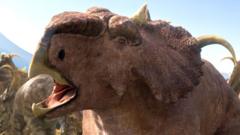Hidden deep within a forest in Alberta, Canada, lies a monumental mass grave containing thousands of dinosaur remains. This significant find, within Pipestone Creek - aptly named the "River of Death" - has drawn the attention of palaeontologists eager to solve a 72-million-year-old puzzle about the circumstances of their demise. Professor Emily Bamforth leads a team attempting to uncover how such a large number of dinosaurs perished rapidly, starting with the heavy impact of a sledgehammer to break through the dense rock that encases the fossils.
As her crew carefully removes layers of dirt, more fossilized bones come into view, including parts of a hip and numerous ribs belonging to the Pachyrhinosaurus. Their meticulous excavation process has so far revealed a unique assemblage of bones estimated to contain up to 300 fossils per square meter, making it one of the largest bone beds in North America.
Not just a treasure trove of Pachyrhinosaurus, this site is providing vital insight into an ancient ecosystem in which these dinosaurs lived during the Late Cretaceous period. These creatures measured around five meters in length and were significant herbivores equipped with a distinctive bony frill and horns.
The excavation season only lasts until autumn, but the urgency is balanced by the astonishing discoveries being made. With evidence indicating that this herd was engaged in a seasonal migration northwards to feed during warmer months, researchers suggest that a cataclysmic event, potentially a flash flood, may have been responsible for their sudden demise.
Two hours from Pipestone Creek lies the Deadfall Hills, another site where larger dinosaur remains, primarily from an Edmontosaurus, have been found washed ashore. Researchers are working to thoroughly analyze the bones, like a large Pachyrhinosaurus skull nicknamed "Big Sam" that reveals insights into individual variations within the species.
As scientists piece together the details surrounding the mass death event, the evidence points towards a natural disaster that caught this vast herd off guard. The palaeontologists are determined to unravel the series of occurrences leading to this catastrophe, with each visit to the site shedding new light on these ancient giants and their once-thriving habitat. The findings will contribute to a comprehensive understanding of the life and environment of the Pachyrhinosaurus as the team continues to excavate and analyze at Pipestone Creek.



















